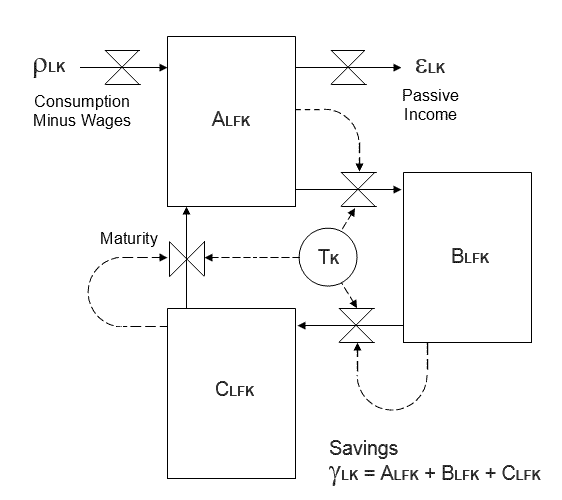Our elementary model of monetary flows must be completed by the control of a typical household sector L’s savings gLK. Where an industrial sector I’s capital account kIK is the residual of what a business has spent but not yet earned (i.e., the integrated difference between sales and costs, including the costs of capital) a household sector L’s savings gLK are the residual of what a household has earned but not yet spent (i.e.: the integrated difference between income=wages+interest and consumption).
One of neoclassicism’s more stalwart positions opposite its heterodox antagonists maintains that savings must equal investment, that a dollar cannot be spent on credit except as another dollar is diverted from immediate consumption into savings; hence all kIK must always be exactly offset by all gLK. Heterodoxy’s position to the contrary has it that capitalism cannot be described other than by a persistent leveraging of investment beyond savings. Though SFEcon does not exist without the neoclassical premise of marginalism, our normative macroeconomics incorporates what we regard as heterodoxy’s superior holding on the question of leverage.
The idea of leverage has (as we shall soon see) a dynamic counterpart in the notion of an investment term T years for saved funds. A variable investment term further incorporates the notion of the risks inherent in financial placements: not only can the value of money change during the period of its commitment, the length of the investment term T can also change.
The figure below has a household sector LK’s financial state gLK disaggregated into the elements of a third-order delay. As with our model of asset depletion we segment this pipeline into three levels: A, B, and C — the sum of which defines savings gLK. By convention, savings positions gLK are negative quanta. Their magnitude is diminished by the action of a positive rLK, which is the difference between consumption and wages. Ideally, consumption can be greater than wages because it is partially offset by passive income eLK. Passive income augments savings by the action of positive eLK decrementing a negative gLK.

But savings, unlike physical assets, are not exhausted after their logistical term of 1/VJ years has run. Presumably one’s principal is returned after an economy K's stated or anticipated investment term TK, giving one the option to reinvest by adding-to or drawing-from principal. The reclaiming of principal is effected by a rate labeled MATURITY that channels effluent from level CLFK to level ALFK.
Level ALFK is the point at which adjustments to savings can be injected into the loop. Consumption-minus-wages rLK entering this chamber are more or less offset by passive income eLK. Stasis requires that 1) interest earned eLK be just sufficient to supply the difference rLK between wages and consumption; and 2) the investment term T must be such that the effluent from ALFK is exactly offset by inflow from CLFK. This is to say that stasis requires savings be uniformly distributed around the circuit of loanable funds.
Model 0’s artificial limit of one financial intermediary per economy K assures us that all dividends eIK generated by the industrial sectors will be continuously distributed as interest payments eLK among the household sectors LK. With the total of interest payments eLK to be distributed defined, distribution is easily accomplished in proportion to a household sector LK’s financial position gLK relative to the total of all savings.